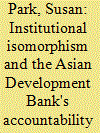| Srl | Item |
| 1 |
ID:
113836


|
|
|
|
|
| Publication |
2012.
|
| Summary/Abstract |
This article analyzes how exchange participants in university-industry agricultural biotechnology research collaborations manage and create differences between the academy and industry with regard to the open dissemination and commercialization of scientific knowledge. Our focus is on the constitutive relations that define the boundary between academic and commercial science. We identify a particular "relational package" that formalizes and standardizes exchanges of money from industry for privileged access to university research discoveries. Our analysis of academic scientists' justificatory narratives about their patenting decisions challenges the oft-made assertion that academic patenting on its face should be taken as evidence of a blurred institutional boundary between academic and commercial science.
|
|
|
|
|
|
|
|
|
|
|
|
|
|
|
|
| 2 |
ID:
184085


|
|
|
|
|
| Summary/Abstract |
How should we understand the formation of the grid management system (网格化管理) of grass-roots governance in China? In this article, I argue that the grid system is an extension of existing governance structures. Facing conflicting central messaging, local grid development encountered isomorphic pressures, leading grids to resemble higher-level administration and to inherit a top–down and stability-focused mode of operation. To support this argument, I analyse five aspects: shifts in elite-level discourse, the proliferation of the grid system, recruitment standards for grid members, grid members’ tasks, and their assessment. Showcasing wide local variety, the grid system retains a managerial approach while collapsing service provision into security.
|
|
|
|
|
|
|
|
|
|
|
|
|
|
|
|
| 3 |
ID:
131888


|
|
|
|
|
| Publication |
2014.
|
| Summary/Abstract |
In the 1990s Multilateral Development Banks created accountability mechanisms (AMs) that allowed people affected by development projects redress. Currently undertheorized, this paper examines how and why the Asian Development Bank (ADB) created an AM, and whether the AM serves its purpose to hold the ADB to account and to provide 'fair hearing of the views of the affected group'. This article argues that the ADB created a new AM because of institutional isomorphism, borrowing the idea of the AM from the World Bank as a result of coercive and mimetic isomorphic processes. Further, that the ADB introduced a mechanism ill-suited to the pre-existing (old) organizational culture of the ADB, which is based on consensus and hierarchical rule-following in the context of ADB operations to further economic growth while upholding state sovereignty. Despite its restructure and recent review, the mechanism's weakness was revealed through a stand-off between China and the AM over an investigation begun in 2009 (creating something 'blue'). The paper concludes that the AM's ability to serve its purpose will remain hampered as long as ADB maintains consensus around economic growth and state sovereignty over providing recourse to affected people.
|
|
|
|
|
|
|
|
|
|
|
|
|
|
|
|
| 4 |
ID:
185346


|
|
|
|
|
| Summary/Abstract |
The paper analyses the Concept Development and Experimentation (CD&E) approach which has been developed and implemented in NATO over the last 20 years. NATO’s CD&E approach is explained as an organisational innovation and institutional response to external and internal pressures. Within the theoretical framing of institutional isomorphism, the paper analyses the adoption of CD&E in the European Union’s (EU) Common Security and Defence Policy (CSDP). The research hypothesis is that the EU will adopt and apply NATO’s CD&E approach in the EU’s defence planning and capability development process. The empirical findings from the analysis of the EU policy practice, however, show that CD&E has actually been adopted from NATO and applied by the EU to a very limited extent. The low degree of isomorphism between NATO and the EU with regard to applying CD&E is explained by a complex set of factors. The research results have broader implications, suggesting that under the current institutional settings it is highly unlikely CD&E to be adopted by other international organisations in the field of international security.
|
|
|
|
|
|
|
|
|
|
|
|
|
|
|
|
| 5 |
ID:
178188


|
|
|
|
|
| Summary/Abstract |
International relations scholarship has paid insufficient attention to security providers’ tendency to emulate the visual attributes of other actors in an attempt to (re)construct their identities and increase their legitimacy by signalling adherence to prevailing norms. Research on the discourses deployed by private military and security companies (PMSCs), for instance, has relied almost exclusively on the analysis of written documents. This article argues that even basic visual units like logos serve as windows into the genealogy and evolution of the international market for force. By combining insights from Peircean semiotics and institutionalist theory, I show that PMSCs’ logos are not only marketing tools, but also symbolic acts that shed light upon the shifting identities and legitimization strategies of the international private security industry. Specifically, I argue that PMSCs’ logos can be conceptualized as forms of camouflaging, blame-shifting, mirroring and socialization into corporate identities. These overlapping processes have reshaped the international private security industry brandscape, informing a shift away from the use of logos displaying symbols and colours borrowed from military visual identity systems.
|
|
|
|
|
|
|
|
|
|
|
|
|
|
|
|